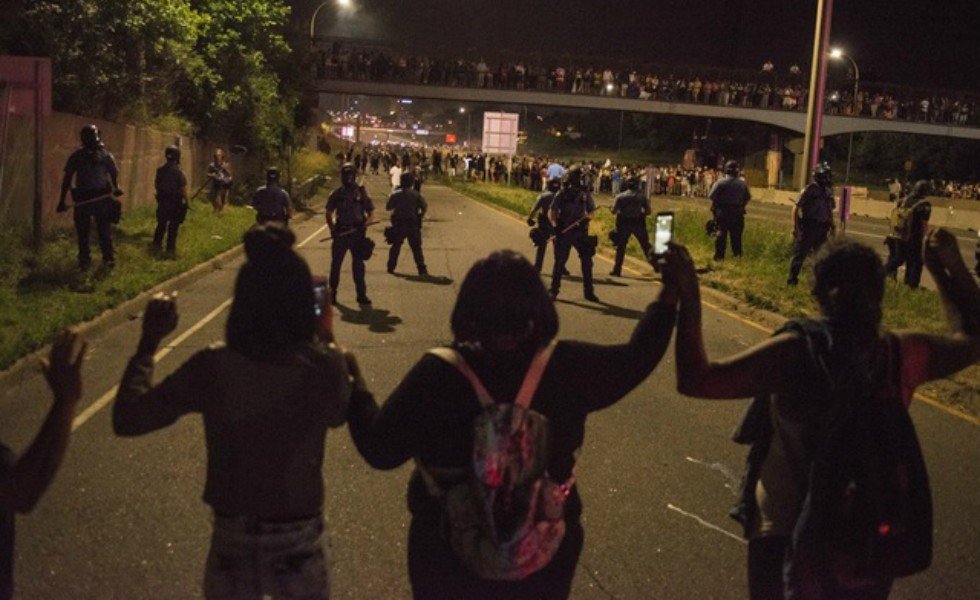Filed under: Action, Critique, Midwest, Police, Repression, White Supremacy

From Unicorn Riot
On July 9th, 2016 Black Lives Matter Minneapolis (BLM-Mpls), along with members of other groups and non-group affiliated young people, led a protest march and shutdown of highway I-94 In St Paul, MN to demand justice for Philando Castile.
During the shutdown, a multi-jurisdiction task force fired multiple rounds of rubber bullets, flash bangs, CS gas, rubber ball grenades, 40mm marker rounds, and pepper spray at protesters. In response, water bottles, rocks, and firecrackers were hurled back by numerous protesters towards police lines.
In recent days, as tensions have grown over issues such as noise levels at occupations and defense against white supremacists, questions of militancy, anarchism, direct action, and community self-defense have shot to the front of public conversation.
During and after the action, prominent BLM-Mpls activists and others made statements asserting that it was solely outside individuals who were instigating self-defense against police.
White anarchists and agent provocateurs have been endangering Black lives this entire shutdown.
— Black Visions Collective (@BlackLivesMpls) July 10, 2016
An organizer also stated through a loudspeaker that “white anarchists” were throwing fireworks onto the highway and thus “endangering black lives”.
Throughout the action, white protesters presumed to be anarchists based on their protective facial masks were verbally pressured and confronted by some BLM-Mpls allies and activists. Black anarchists and others were seen coming to the defense of their white friends before, during, and after the I-94 demonstrations, arguing the importance of focusing energy on fighting for social and economic justice instead of blaming their own allies for police repression.
An anonymous black anarchist organizer summed up their frustration and stance on militancy by stating:
I’m tired of this. Honestly. I’m gonna say some shit and I’m not gonna censor anything and you need to understand. Niggas been fuckin’ shit up. And by this I mean both at the 4th precinct and at 1-94. The militance that I’ve witnessed has been by hood niggas … with no politics and with no fucks given. I’m starting to understand that white liberals’ quest to seem so “not racist” and “POC-friendly,” and black leaders’ internalized respectability, has people completely ignoring the existence of black militance. That’s what I’ve seen. At the same time, I was too busy trying not to get hit with marker rounds up front to see everything, but if they were doing anything, white anarchists certainly weren’t alone.
The implied targets of BLM-Mpls criticism and their supporters expressed their own frustration of BLM-Mpls’s statements. “Phillip”, an organizer with the IWW’s General Defense Committee (GDC), stated
White ally means fighting back. It doesn’t mean taking orders from some leader/authority on the megaphone. It means fighting back SIDE BY SIDE with our melanated comrades, not standing in front of them and snitching to the peace police that people are picking up rocks.
There is historical precedent of political repression of anarchists in Minnesota, from 1917’s raids against radicals in Duluth and Minneapolis during the first Red Scare, to 2007-2009 when Twin Cities anarchists faced state and federal law enforcement house raids and nuisance charges around the RNC.
The 2008 RNC also saw the “St Paul Principles” adopted, supporting a diversity of tactics, supported by a wide range of activist groups, avoiding any public or media denunciations of fellow activists and events.
As multiple networks mobilized politically under the banner of “Occupy” in 2011, dozens, if not hundreds of groups, like Oakland, considered adopting variants of the St Paul Principles in order to create more political cover for radical action.
In this broader context, in the last decade, counter-currents against militant action from more mainstream groups and the state also emerged. In numerous instances, the more mainstream side have often symbolized their antagonists as some type of ‘outside agitators’ and ‘white anarchists’ in congruence with the state’s common strategy of dividing ‘good protesters’ and ‘bad protesters’ – the very dichotomy the St Paul Principles helped prevent.
On Nov. 19th, 2015, during last year’s occupation of the 4th Precinct, Minneapolis police department (MPD) chief Janeé Harteau held a press conference where she made similar claims, blaming “[anarchists] from outside of the community” for inciting violence.
The March 2016 report by Ikemba Kuti, “The 4th Precinct: A Black Anarchist’s Perspective on Struggle in Minneapolis’ Northside Streets” reflects on this critical situation for Anarchist People of Color (APOC) who engaged there last year.
Last year in North Minneapolis, several protesters were shot and wounded by white supremacists; this seemed to created a conundrum where armed militant defense was suddenly an imminent matter of survival, a major problem for mainstream nonprofit organizations that don’t usually find themselves in this position. A critical point: This problem hasn’t been resolved, which has led directly to the political tensions we see today.
In our coverage of protests and militant street actions, as well as discussion panels, the Unicorn Riot team has worked to keep our platform open in order to recognize the critical roles of many different types of people. Through working with so many members of the community, we strive to amplify voices of the people with more range and nuance than any one group has to offer.
We will keep you updated as this important conversation among activists continues.
Watch the full unedited 3-hour live stream below:





